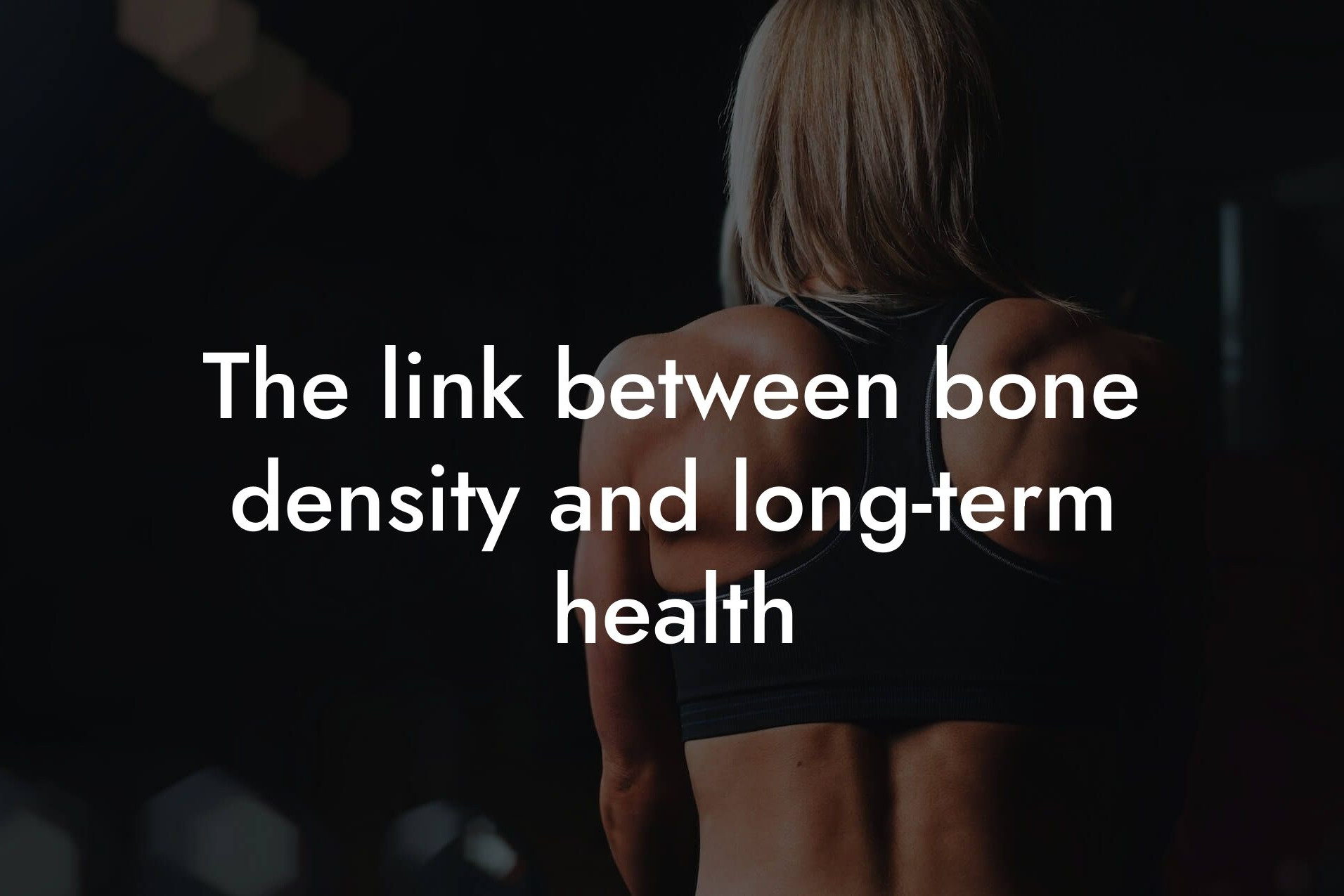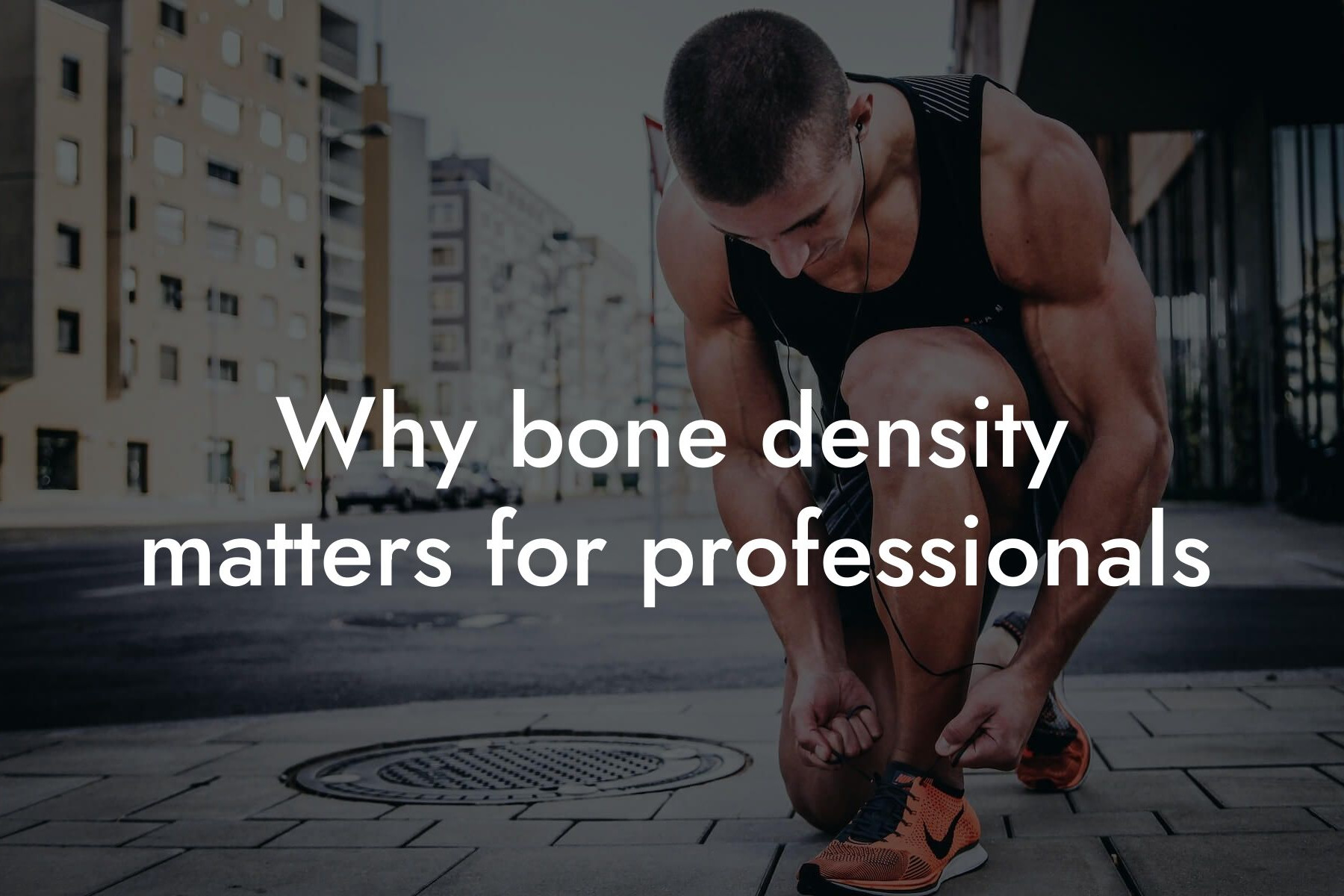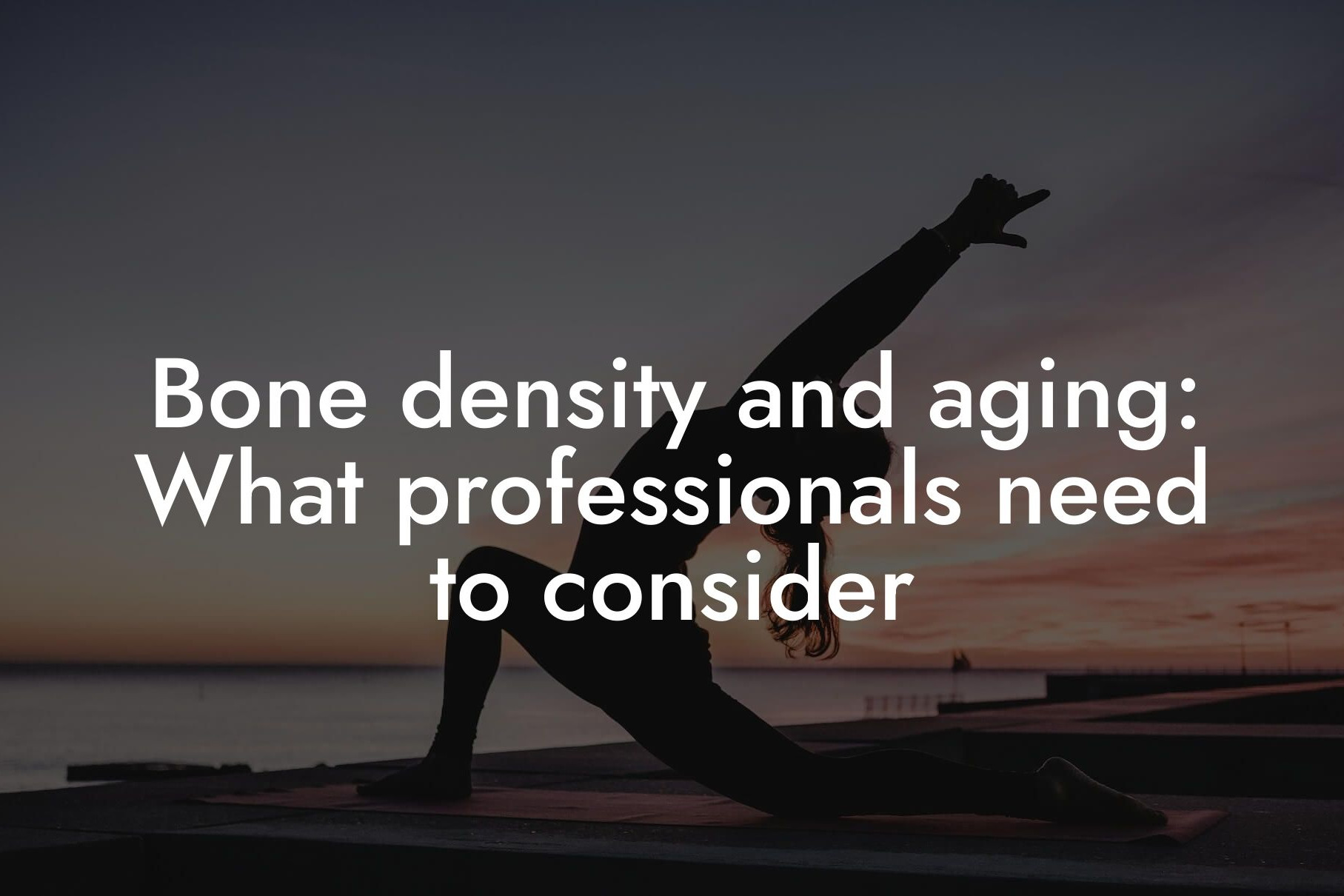As high-earning professionals, you understand the importance of maintaining a healthy and strong physique. One crucial aspect of overall health is bone density, which can significantly impact your quality of life as you age. At Tano Performance Group, we're committed to providing you with the knowledge and tools you need to optimize your bone health. In this article, we'll delve into the best exercises for increasing bone density, helping you to take control of your physical appearance and overall well-being.
Table of Contents
Understanding Bone Density
Bone density refers to the measure of how dense and strong your bones are. As we age, our bone density naturally decreases, which can lead to osteoporosis, a condition characterized by brittle and fragile bones. This can increase the risk of fractures, osteoarthritis, and other mobility issues. Maintaining strong bones is essential for preventing these conditions and ensuring a healthy, active lifestyle.
Why Exercise is Crucial for Bone Density
Exercise plays a vital role in building and maintaining strong bones. When you engage in regular physical activity, your bones respond by becoming stronger and denser. This is because exercise stimulates the production of osteoblasts, the cells responsible for bone growth and repair. Additionally, exercise helps to improve muscle mass and strength, which further supports bone health.
Types of Exercise that Promote Bone Density
Not all exercises are created equal when it comes to building bone density. The most effective exercises for bone health are those that involve weight-bearing activities, resistance training, and high-impact movements. These types of exercises stimulate the bones to adapt and grow stronger, leading to increased density.
Weight-Bearing Exercises
Weight-bearing exercises are those that involve supporting your own body weight or external loads. Examples of weight-bearing exercises include:
- Walking or hiking
- Running or jogging
- Dancing
- Jumping rope
- Stair climbing
These exercises are excellent for building bone density in the hips, spine, and legs.
Resistance Training Exercises
Resistance training exercises involve using weights, resistance bands, or your own body weight to challenge your muscles. Examples of resistance training exercises include:
- Squats
- Lunges
- Deadlifts
- Bench press
- Rows
Resistance training exercises are effective for building bone density in the upper body, including the arms, shoulders, and chest.
High-Impact Exercises
High-impact exercises involve rapid, forceful movements that stimulate bone growth. Examples of high-impact exercises include:
- Jumping jacks
- Box jumps
- Burpees
- Kettlebell swings
High-impact exercises are excellent for building bone density in the hips, spine, and legs.
Sample Workout Routine for Bone Density
To get you started, here's a sample workout routine that incorporates exercises for bone density:
- Warm-up: 5-10 minutes of light cardio (jogging, jumping jacks, etc.)
- Weight-bearing exercises: 3 sets of 10-15 reps of squats, lunges, and calf raises
- Resistance training exercises: 3 sets of 10-15 reps of deadlifts, bench press, and rows
- High-impact exercises: 3 sets of 10-15 reps of jumping jacks, box jumps, and burpees
- Cool-down: 5-10 minutes of stretching
Remember to start slowly and gradually increase the intensity and frequency of your workouts as you become more comfortable.
Incorporating DEXA Scans into Your Fitness Routine
At Tano Performance Group, we understand the importance of tracking your progress and making data-driven decisions about your fitness routine. That's why we recommend incorporating DEXA scans into your routine. DEXA scans provide a comprehensive assessment of your body composition, including bone density, muscle mass, and body fat percentage. With this information, you can tailor your workout routine to optimize your bone health and overall physique.
Maintaining strong bones is crucial for overall health and well-being. By incorporating exercises that promote bone density into your fitness routine, you can take control of your bone health and reduce the risk of osteoporosis and other mobility issues. Remember to start slowly, listen to your body, and track your progress with regular DEXA scans. With patience, dedication, and the right guidance, you can achieve optimal bone health and take your physical appearance to the next level.
Frequently Asked Questions
What is bone density, and why is it important?
Bone density refers to the measure of how thick and strong your bones are. It's an important indicator of overall health, as strong bones can support your body's weight and withstand everyday activities without breaking or fracturing. Low bone density, also known as osteoporosis, can lead to brittle bones, increased risk of fractures, and even disabilities.
What causes low bone density?
Several factors can contribute to low bone density, including genetics, hormonal changes, certain medical conditions, and lifestyle choices. Some common causes include menopause, thyroid disorders, vitamin D deficiency, and a diet low in calcium and vitamin D. Additionally, a sedentary lifestyle, smoking, and excessive alcohol consumption can also contribute to low bone density.
How do I know if I have low bone density?
If you're concerned about your bone density, consult with your doctor or a healthcare professional. They may recommend a bone density test, such as a dual-energy X-ray absorptiometry (DXA) scan, to measure your bone density. This test can help identify osteoporosis or low bone density before symptoms appear.
What are the best exercises for increasing bone density?
Resistance training and weight-bearing exercises are excellent for building strong bones. Some of the best exercises for increasing bone density include squats, lunges, deadlifts, and leg press. Additionally, high-impact activities like running, jumping, and dancing can also help stimulate bone growth.
Do I need to start exercising at a young age to improve bone density?
While it's true that peak bone mass is achieved during childhood and adolescence, it's never too late to start exercising to improve bone density. Even small amounts of exercise can make a significant difference, especially for older adults. However, the earlier you start, the better your chances of building strong bones and reducing the risk of osteoporosis.
How often should I exercise to improve bone density?
Aim to exercise at least three to four times a week, with a minimum of 30 minutes per session. Consistency is key, so try to make exercise a regular part of your routine. It's also essential to incorporate rest days to allow your bones to recover and rebuild.
What types of exercises are most effective for improving bone density in the hips and spine?
Exercises that target the hip and spine, such as squats, lunges, and deadlifts, are excellent for improving bone density in these areas. Additionally, exercises that involve twisting and bending, like yoga or Pilates, can also help strengthen the muscles and bones in the hips and spine.
Can exercise alone improve bone density?
While exercise is an essential component of improving bone density, it's not the only factor. A balanced diet rich in calcium and vitamin D, as well as adequate sleep and stress management, are also crucial for building strong bones. Consult with a healthcare professional to develop a comprehensive plan tailored to your needs.
How long does it take to see improvements in bone density?
Improvements in bone density can take time, typically several months to a year or more, depending on factors like age, exercise frequency, and diet. Be patient and consistent with your exercise routine, and you'll be more likely to see positive changes over time.
Are there any specific exercises that can help improve bone density in the wrists and hands?
Yes, exercises that target the wrists and hands, such as wrist curls and extensions, can help improve bone density in these areas. Additionally, activities like yoga or Pilates that involve weight-bearing exercises for the hands and wrists can also be beneficial.
Can I improve bone density through diet alone?
While diet plays a crucial role in building strong bones, it's unlikely to improve bone density significantly through diet alone. A balanced diet rich in calcium and vitamin D is essential, but exercise and other lifestyle changes are also necessary to see significant improvements.
What are some foods that can help improve bone density?
Foods rich in calcium, vitamin D, and other essential nutrients can help support bone health. Some examples include dairy products, leafy greens, fortified cereals, and fatty fish like salmon. Consult with a registered dietitian or healthcare professional to develop a personalized meal plan.
Can I take supplements to improve bone density?
While supplements can be helpful, it's essential to consult with a healthcare professional before adding any supplements to your routine. Calcium and vitamin D supplements are commonly recommended, but it's crucial to ensure you're getting the right dosage and type of supplement for your individual needs.
How does menopause affect bone density?
Menopause can lead to a significant decline in bone density due to the decrease in estrogen levels. This hormone plays a crucial role in regulating bone metabolism, so the decline can lead to rapid bone loss. However, exercise, diet, and hormone replacement therapy can help mitigate this decline.
Can I improve bone density if I have osteoporosis?
Yes, it's possible to improve bone density even if you have osteoporosis. However, it's essential to work with a healthcare professional to develop a comprehensive treatment plan that includes exercise, diet, and potentially medication. With the right approach, you can slow down bone loss and even rebuild bone tissue.
How does smoking affect bone density?
Smoking is a significant risk factor for low bone density and osteoporosis. The toxins in tobacco can interfere with bone metabolism, leading to weaker bones. Quitting smoking can help reduce this risk and improve overall bone health.
Can I improve bone density if I have a family history of osteoporosis?
Yes, even if you have a family history of osteoporosis, you can take steps to improve your bone density. Focus on a balanced diet, regular exercise, and a healthy lifestyle to reduce your risk of developing osteoporosis.
How does exercise improve bone density?
Exercise improves bone density by stimulating bone growth and strengthening the muscles and bones. Weight-bearing exercises, in particular, can help stimulate the formation of new bone tissue, leading to stronger, denser bones.
Can I improve bone density through yoga or Pilates?
Yes, yoga and Pilates can be beneficial for improving bone density, especially in the hips, spine, and wrists. These exercises can help strengthen the muscles and bones, improve flexibility, and reduce the risk of falls and fractures.
How does age affect bone density?
Age is a significant risk factor for low bone density and osteoporosis. As we age, our bones naturally lose density, making us more susceptible to fractures and osteoporosis. However, regular exercise and a healthy lifestyle can help slow down this decline and improve bone health.
Can I improve bone density if I have a medical condition?
Yes, even if you have a medical condition, you can take steps to improve your bone density. Consult with your healthcare professional to develop a personalized plan that takes into account your specific condition and needs.
How does stress affect bone density?
Chronic stress can negatively impact bone density by increasing the production of cortisol, a hormone that can interfere with bone metabolism. Managing stress through exercise, meditation, or other relaxation techniques can help reduce this risk and improve overall bone health.
Can I improve bone density if I'm overweight or obese?
Yes, even if you're overweight or obese, you can take steps to improve your bone density. Focus on a balanced diet, regular exercise, and a healthy lifestyle to reduce your risk of developing osteoporosis and improve overall bone health.
Here are some related articles you might love...
- The link between bone density and long-term health
- Why bone density matters for professionals
- Bone density and aging: What professionals need to consider
- How to improve bone density naturally
- Understanding osteoporosis and its risks
- DEXA scan for bone density: What you need to know
- The role of calcium and vitamin D in bone health
- How stress affects bone density
- Nutrition tips for stronger bones
Zak Faulkner
Zak Faulkner is a leading authority in the realm of physical health and body composition analysis, with over 15 years of experience helping professionals optimise their fitness and well-being. As one the experts behind Tano Performance Group, Zak has dedicated his career to providing in-depth, science-backed insights that empower clients to elevate their physical performance and overall health.
With extensive knowledge of DEXA technology, Zak specializes in delivering comprehensive body assessments that offer precise data on body fat, muscle mass, bone density, and overall physique. His expertise enables individuals to make informed decisions and achieve their fitness goals with accuracy and confidence. Zak’s approach is rooted in a deep understanding of human physiology, combined with a passion for helping clients unlock their full potential through personalised strategies.
Over the years, Zak has earned a reputation for his commitment to excellence, precision, and client-focused service. His guidance is trusted by top professionals who demand the best when it comes to their health. Whether advising on fitness programs, nutritional strategies, or long-term wellness plans, Zak Faulkner’s insights are a valuable resource for anyone serious about taking their health and fitness to the next level.
At Tano Performance Group, Zak continues to lead our Content Team revolutionising how professionals approach their physical health, offering unparalleled expertise that drives real results.




